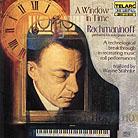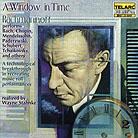June 1999
There were three major sources of piano rolls: the Welte-Mignon company (to whom we must give thanks for the only extant recordings of Gustav Mahler playing his music), who flourished before World War I ,and two American companies: Aeolian Duo Art and Ampico, whose very successful businesses were finished off by the Great Depression rather than by competition from the gramophone. Great pianists recorded for all three companies, often contributing extravagant testimonials to their accuracy -- but keeping their private thoughts to themselves. Some even had to be bribed into allowing the rolls to be released: after first hearing the results, the great Venezuelan pianist Teresa Carreno, "The Valkyrie of the keyboard," refused to approve her Welte-Mignon rolls until she was presented a car by the company. To read the liner notes with these two new Telarc CDs (all taken from Ampico rolls made in the 1920s), whose very title implies something very special, you would be forgiven for thinking that any such concerns have been conquered by the new technology. Yet, it is not possible to reproduce details that were never recorded in the first place, and this surely is the case with piano rolls. The great pianist Josef Hofmann -- one of Rachmaninoff's few peers -- wrote in 1955 to critic and writer Harold C. Schonberg: "As regards the Duo Art rolls...they did well for a while, for at that period the phonograph records were unable to reproduce the piano tone faithfully. Rhythmically they were all correct; dynamically they were a fake." "Fake" may seem a strong word, but in the fact the mechanisms for recording the pianist could not capture dynamics and nuances of touch -- these were added later, often with the help of the artists, but often not. The seriousness with which Hofmann took this position can be judged from the fact that he spent years himself building a device to capture precisely those missing elements. Unfortunately he perfected it in 1929, just in time for the Crash. This has been a long, but necessary preamble to discussing the two discs here. Rachmaninoff was undoubtedly one of the great pianists of the century; unfortunately he died before the advent of either the tape-recorder or the LP and for many people listening to sound transferred from 78s is less than pleasurable. But now we have these two discs which "reveal the subtleties and fine details of Rachmaninoff's playing with startling clarity." With all due respect to the considerable research and work that went into these discs, I beg to differ. Rachmaninoff duplicated a great deal of his recorded repertoire and so it is possible to do a direct comparison with some of the pieces contained herein. Wayne Stahnke, whose work this is, tells us in his liner note that he was able to use 78s as the basis for determining precisely what speed to play back the rolls. I conducted back-to-back comparisons of several items: from the first volume the (in)famous Prelude in C sharp minor, from the second the Mendelssohn Spinning Song and the two Chopin Waltzes. While the musical approach in both record and roll is almost identical, I invariably felt a greater sense of spontaneity and nuance in the 78 transfers, which -- even with the 1920 pre-electric recordings -- provided far more musical enjoyment than the rolls. Still, this is Rachmaninoff's playing, so to speak, and overall the discs are enjoyable. Of course, the 78s are in mono and the piano tone is inevitably restricted -- and, notoriously, the hardest instrumental sound to reproduce accurately. But then I have a hard time believing that Rachmaninoff actually produced such an ugly, clanging forte in the left hand as is heard on these discs. And certainly the Josef Lhevinne Duo Art rolls that Decca transferred two decades ago suffered from no such shortcomings. Rachmaninoff completists will undoubtedly want these discs, and anyone else who is interested in the history of great pianism should investigate them too. My personal lack of enthusiasm for the technology should not be held against Rachmaninoff, whose unique musicianship in many ways forms a bridge between the more individualistic (some would say self-indulgent) style of an earlier generation and the more "objective" style fashionable today. If you're unfamiliar with Rachmaninoff's playing and don't find 78 sound too objectionable, then I'd strongly suggest trying some of the actual recordings first. If you really can't take the sound of 78s, then these discs are certainly the next best thing. GO BACK TO: |
 A Window in Time
- Music of Rachmaninoff
A Window in Time
- Music of Rachmaninoff  A Window in Time - Music of Rachmaninoff, Bach, Chopin,
et. al.
A Window in Time - Music of Rachmaninoff, Bach, Chopin,
et. al.![[Reviewed on CD]](../format/regcd.gif) The
great pianist Artur Schnabel was approached by one of the companies that manufactured
piano rolls early in this century and invited him to record for them. "Our
system," they proudly told him, "can reproduce 16 different degrees of
touch." "What a pity!" Schnabel replied. "You see, I have
seventeen." And that, in a way, neatly encapsulates the problems with reproduced
piano rolls: can we ever be sure that the recording machinery captured exactly what
was being played?
The
great pianist Artur Schnabel was approached by one of the companies that manufactured
piano rolls early in this century and invited him to record for them. "Our
system," they proudly told him, "can reproduce 16 different degrees of
touch." "What a pity!" Schnabel replied. "You see, I have
seventeen." And that, in a way, neatly encapsulates the problems with reproduced
piano rolls: can we ever be sure that the recording machinery captured exactly what
was being played?